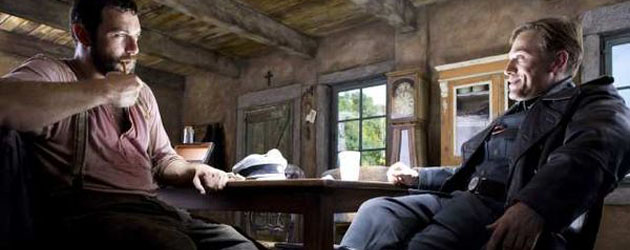David Wasco & Sandy Reynolds-Wasco

AS: You work as a husband and wife Production Designer/Set Decorator team. Dante Ferretti’s wife is also his set decorator. He said it makes things easier.
DW: We do this all the time and it makes a big difference. It’s like having two production designers.
AS: Does it ever feel like you can never get away from it?
SRW: When we take the job, we don’t set the movie aside at dinner to catch up on real world events. It’s never set aside! Good or bad, we’re absorbed and it’s 24/7 when we’re doing it. It doesn’t matter that it’s sort of overwhelming because it gives you piece of mind in the long run. You’ve got the jump, you’re organized and it also really helps with all the compressed prep time lately. Even in the interview process, working closely helps because we’re able to break down the script together, share research and ideas or questions to offer a director. What’s good is that we both fill in where the other one’s weaker. After we’re hired and as locations begin to be chosen, that cord is broken. David really becomes the Director’s liaison to the Art Department and I focus on managing my department.
AS: When you go into a meeting do you go in together?
DW: No. The interview process is me alone. But I exploit Sandy’s contribution in prepping. I use the benefits of having two art directors like we are, having two people there that can visualize and figure out the project. When we go in and start working on the project Sandy will have her own meetings to discuss the set decorating, talking about all this ephemera that you surround the actors with that help the director tell the story and I’ll have my separate meetings about the art direction of the movie. But in describing the physical office I like to have a bull-pen situation where of course Sandy and the art director will have their own offices, and I’ll have my own office, but we’ll all function in a big, open area where when you get these little bits of lucky time when the director comes in and sits at a table we’re all listening to what he or she is saying. It’s a nervous hour or so and then when they leave we can all compare notes on what they said because everybody hears different things.
SRW: Everybody’s focused on something they need to hear but it’s always good to hear what everybody else has to say. Anyone can contribute in that situation. P.A.’s can add, illustrators can add their two cents and it’s all good.
DW: Absolutely. I really am a collaborator and I like to solicit from everybody. First of all I try to crew up my art department with almost everybody being overqualified and really, really talented. Even in an art assistant or for that matter an intern that’s not getting paid anything, I like having somebody that’s really sharp. And I let them listen also when the director comes in. They can be doing Xeroxing or something but they’re listening. I encourage a free and open environment that’s not all just David Wasco talking, Well, this is what we’re going to do! Instead it’s like, Guys what’s the best idea? If the best idea comes from the intern we’re going to use the best idea. And I’ll give credit. It’s truly the most collaborative art form of our time. I liken it to an architecture firm that has to build a skyscraper. You have a thousand people working on this building and a lot is riding on every individual person.
Thank you for publishing such a great, in-depth interview with The Wasco’s! – it really captures how wonderful and talented they are, and their love and respect for cinema and architecture. And I really enjoy your blog in general – what a cool resource of ongoing conversations! Keep it up!
Robert Foulkes/Location Manager
I agree with Robert. I’ve read every single one of your interviews and everyone offers such great advice. Inglorious Bastards was such a great film and to hear their story makes it even better. I’m on the distribution and sales side of the business, but my passion has always been designing and art, so to read these stories is truly inspiring.
Thank you!!!